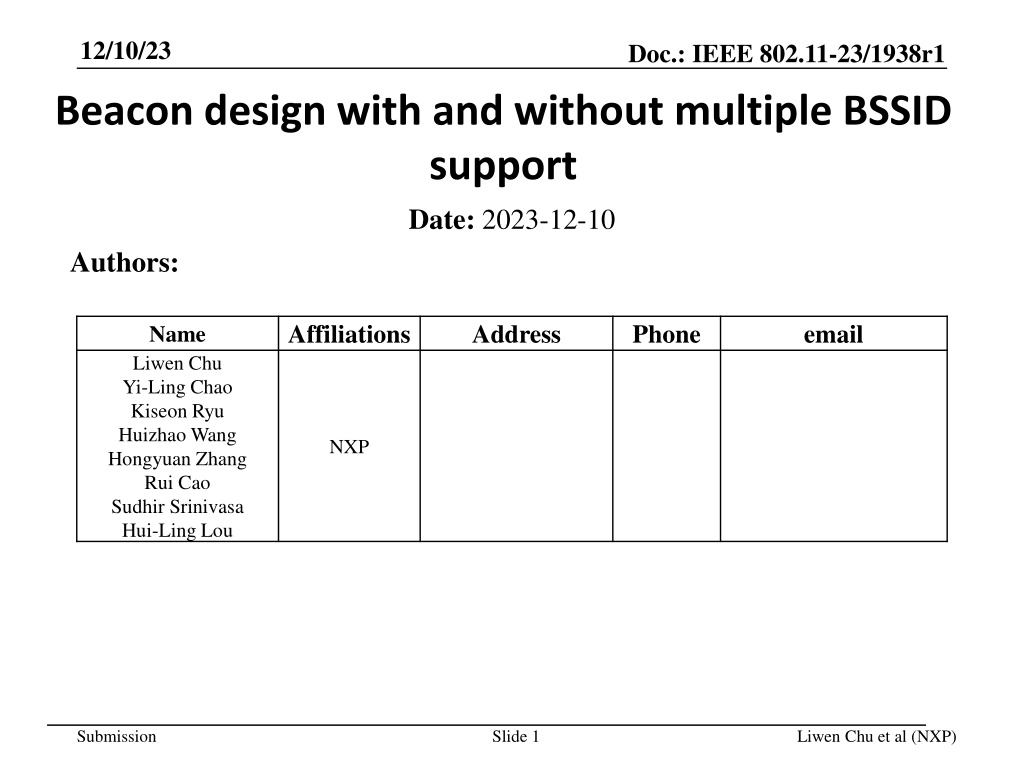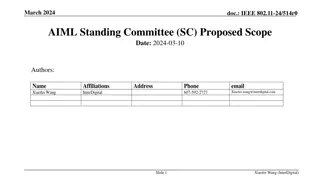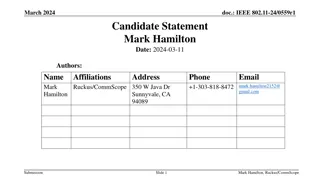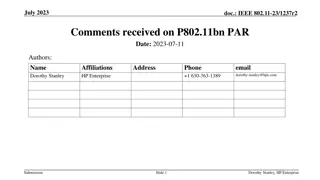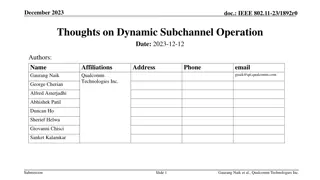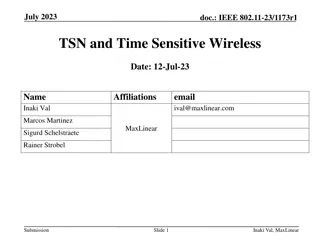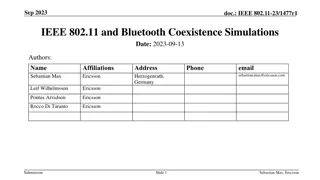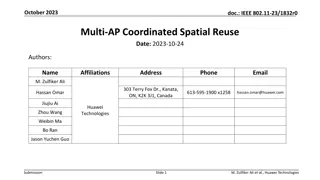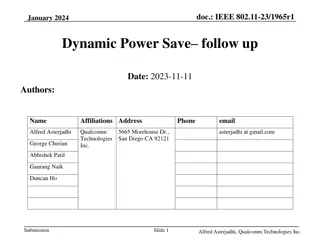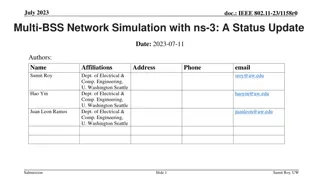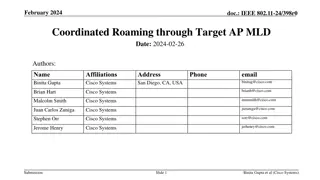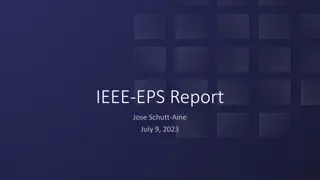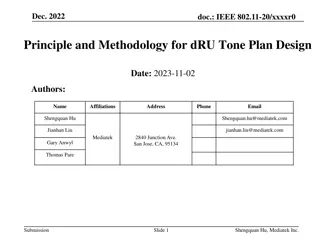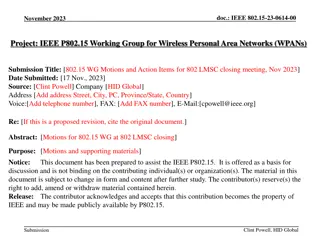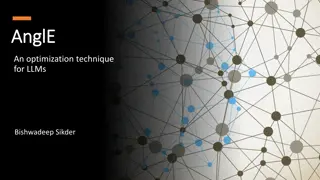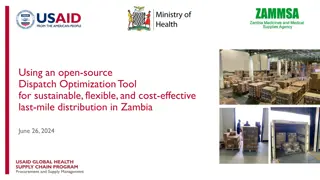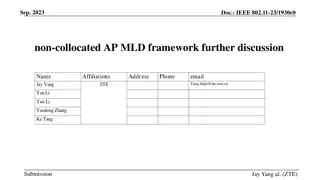IEEE 802.11-23/1938r1 Beacon Design and Optimization
This document discusses the design and optimization of IEEE 802.11-23/1938r1 beacons with and without multiple BSSID support. Topics include beacon frame structure, probe response information, beacon overhead reduction, BSS management, active and passive scanning procedures, and beacon information analysis for power save STAs. The authors from NXP provide insights into optimizing beacon functionality for efficient wireless network operations.
Download Presentation
Please find below an Image/Link to download the presentation.
The content on the website is provided AS IS for your information and personal use only. It may not be sold, licensed, or shared on other websites without obtaining consent from the author. Download presentation by click this link. If you encounter any issues during the download, it is possible that the publisher has removed the file from their server.
Presentation Transcript
12/10/23 Doc.: IEEE 802.11-23/1938r1 Beacon design with and without multiple BSSID support Date: 2023-12-10 Authors: Affiliations Address Phone email Name Liwen Chu Yi-Ling Chao Kiseon Ryu Huizhao Wang Hongyuan Zhang Rui Cao Sudhir Srinivasa Hui-Ling Lou NXP Submission Slide 1 Liwen Chu et al (NXP)
12/10/23 Doc.: IEEE 802.11-23/1938r1 Recap: ML Operation The Beacon frame, Probe Response carry part information of the AP MLD for decreasing the Beacon overhead. The Beacon frame, Probe Response carry the critical update of the reporting AP, the channel switch related elements, Quiet element of the reported AP that is affiliated with the same AP MLD as the reporting AP. The reported AP is on a link other than the link where the Beacon or Probe Response is transmitted. The ML Probe procedure allows a non-AP MLD to acquire the full information of an AP MLD through one link. The ML Probe Response frame also carries the critical update of the reported AP where the reported AP is one of the following. Submission Slide 2 Liwen Chu et al (NXP)
12/10/23 Doc.: IEEE 802.11-23/1938r1 Recap: Beacon Optimization The Beacon is used to carry the BSS management information. The UHR information is not carried in Beacon. An Indication of UHR support is carried in the Beacon frame. If all the association STAs are UHR STAs, the further optimization can be done, i.e. the Beacon can carry the dynamic information and the basic information for the association TIM, SSID, security related information, . Submission Slide 3 Liwen Chu et al (NXP)
12/10/23 Doc.: IEEE 802.11-23/1938r1 Active Scanning and Passive Scanning in 802.11 A STA may wait for Beacon in passive scanning procedure. A STA may use active scanning procedure to acquire the AP s full information. This is required under MLD by using one link to acquire the other link s information. This is required when the light Beacon is used in the BSS and the UHR information is not carried in the Beacon. This is required when the light Beacon is used in the BSS with association from non- UHR-STA being disabled and the minimal necessary information not carried in the Beacon. Submission Slide 4 Liwen Chu et al (NXP)
12/10/23 Doc.: IEEE 802.11-23/1938r1 Beacon Information Analysis TIM, optional Multi-Link Traffic Indication These element are useful for power save STAs. Optional MME This element is needed if the Beacon protection is required. Optional Transmit Power Envelope (TPE) The information is useful for active scanning if the BSS operating channel has the Tx power restriction. The BSS operating parameters BSS Color. These parameter is needed when UHR PPDU is used for active scanning. Primary 20MHz channel. These parameter is needed when the light Beacon is transmitted in duplicate PPDU. BSS operating channel and channel puncture information. These parameters are needed if the full BSS BW is used for active scanning. SSID This parameter is needed if SSID is used for deciding whether the full BSS information is probed. Short SSID may be an alternative for shorter light Beacon. Submission Slide 5 Liwen Chu et al (NXP)
12/10/23 Doc.: IEEE 802.11-23/1938r1 Beacon Information Analysis (Cont d) Critical update The Critical Update Flag, Nontranmsitted BSSIDs Critical Update Flag, BPCC are required for a STA and the non- AP MLD with which a STA is affiliated to probe the critical update. Security information RSNE is useful for STA to decide whether it can associate with the AP. Multiple BSSID information The SSID of each nontransmitted BSSID is required if SSID is used for deciding whether the full BSS information is probed. The Short SSID for each nontransmitted BSSID AP may be an alternative for shorter light Beacon. The other information in nontransmitted BSSDI profile is less useful AP MLD information. The BPCC related to reported AP Submission Slide 6 Liwen Chu et al (NXP)
12/10/23 Doc.: IEEE 802.11-23/1938r1 Light Beacon without Multiple BSSID Support When an AP doesn t support/enable Multiple BSSID and allows the non-UHR STA s association, the AP transmit its Beacon with pre-UHR information and UHR support indication. When an AP doesn t support/enable Multiple BSSID and doesn t allow the non-UHR STA s association, the AP transmit its Beacon with minimal information: TIM, Multi-Link Traffic Indication if TID-to-Link mapping 3 is enabled. BSS operating channel information for at least primary 20MHz channel and BSS Color. MME for Beacon protection TPE RSNE Critical Update Flag and BPCC BPCC is useful for extreme low power STA. Additionally, the other information can also be considered SSID etc. information can help the STA to decide whether sending Probe Request is reasonable. Submission Slide 7 Liwen Chu et al (NXP)
12/10/23 Doc.: IEEE 802.11-23/1938r1 Light Beacon with Multiple BSSID Support When an AP has transmitted BSSID AP and at least one AP in the multiple BSSID set allows the non-UHR STA s association, the AP transmit its Beacon with pre-UHR information and UHR support indication. When an AP has transmitted BSSID AP and all APs in the multiple BSSID set don t allow the non-UHR STA s association, the AP transmit its Beacon with minimal information: TIM, Multi-Link Traffic Indication if TID-to-Link mapping 3 is enabled. BSS operating channel information for at least primary 20MHz channel and BSS Color. MME for Beacon protection TPE RSNE Critical Update Flag and BPCC BPCC is useful for extreme low power STA. Nontransmitted BSSID Update Flag, SSID, Critical Update Flag and BPCC for nontransmitted BSSID AP. Additionally, the other information can also be considered SSID etc. information for transmitted BSSID AP can help the STA to decide whether sending Probe Request is reasonable. Submission Slide 8 Liwen Chu et al (NXP)
